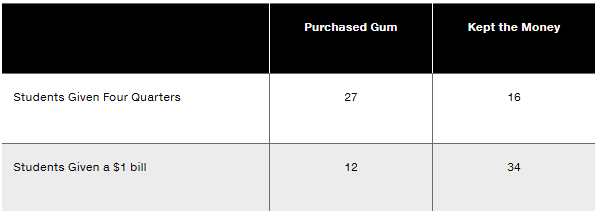Table of contents
- 1. Intro to Stats and Collecting Data55m
- 2. Describing Data with Tables and Graphs1h 55m
- 3. Describing Data Numerically1h 45m
- 4. Probability2h 16m
- 5. Binomial Distribution & Discrete Random Variables2h 33m
- 6. Normal Distribution and Continuous Random Variables1h 38m
- 7. Sampling Distributions & Confidence Intervals: Mean1h 3m
- 8. Sampling Distributions & Confidence Intervals: Proportion1h 12m
- 9. Hypothesis Testing for One Sample1h 1m
- 10. Hypothesis Testing for Two Samples2h 8m
- 11. Correlation48m
- 12. Regression1h 4m
- 13. Chi-Square Tests & Goodness of Fit1h 20m
- 14. ANOVA1h 0m
4. Probability
Complements
Problem 4.3.14a
Textbook Question
Denomination Effect
In Exercises 13–16, use the data in the following table. In an experiment to study the effects of using four quarters versus a $1 bill, some college students were given four quarters and others were given a $1 bill, and they could either keep the money or spend it on gum. The results are summarized in the table (based on data from “The Denomination Effect,” by Priya Raghubir and Joydeep Srivastava, Journal of Consumer Research, Vol. 36).

Denomination Effect
a. Find the probability of randomly selecting a student who spent the money, given that the student was given a $1 bill.
 Verified step by step guidance
Verified step by step guidance1
Step 1: Understand the problem. We are tasked with finding the probability of a student spending the money, given that the student was given a $1 bill. This is a conditional probability problem.
Step 2: Recall the formula for conditional probability: \( P(A \mid B) = \frac{P(A \cap B)}{P(B)} \). Here, \( A \) is the event 'student spent the money' and \( B \) is the event 'student was given a $1 bill'.
Step 3: Identify the relevant data from the table. From the table, the number of students given a $1 bill is \( 12 + 34 = 46 \). Out of these, the number of students who spent the money (purchased gum) is \( 12 \).
Step 4: Calculate \( P(B) \), the probability of a student being given a $1 bill. This is the total number of students given a $1 bill divided by the total number of students in the experiment. Total students = \( 27 + 16 + 12 + 34 = 89 \). So, \( P(B) = \frac{46}{89} \).
Step 5: Calculate \( P(A \cap B) \), the probability of a student being given a $1 bill and spending the money. This is the number of students who were given a $1 bill and spent the money divided by the total number of students. \( P(A \cap B) = \frac{12}{89} \). Substitute these values into the conditional probability formula to find \( P(A \mid B) \).
 Verified video answer for a similar problem:
Verified video answer for a similar problem:This video solution was recommended by our tutors as helpful for the problem above
Video duration:
4mPlay a video:
Was this helpful?
Key Concepts
Here are the essential concepts you must grasp in order to answer the question correctly.
Probability
Probability is a measure of the likelihood that a particular event will occur, expressed as a number between 0 and 1. In this context, it helps determine the chance of a student spending their money on gum given that they received a specific denomination. The formula for calculating probability is the number of favorable outcomes divided by the total number of possible outcomes.
Recommended video:

Introduction to Probability
Conditional Probability
Conditional probability refers to the probability of an event occurring given that another event has already occurred. In this case, we are interested in the probability of students spending their money on gum, conditioned on them having received a $1 bill. This concept is crucial for understanding how the choice of currency affects spending behavior.
Recommended video:

Introduction to Probability
Denomination Effect
The Denomination Effect is a behavioral economics concept that suggests individuals are more likely to spend money when it is in smaller denominations compared to larger ones. This phenomenon can influence consumer behavior, as seen in the experiment where students given quarters were more likely to purchase gum than those given a $1 bill. Understanding this effect is essential for interpreting the results of the study.
Recommended video:

Permutations of Non-Distinct Objects

 4:23m
4:23mWatch next
Master Complementary Events with a bite sized video explanation from Patrick
Start learningRelated Videos
Related Practice

